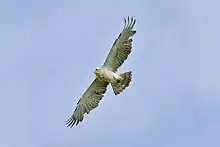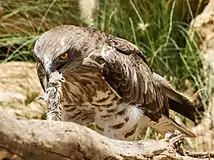Short-toed snake eagle
The short-toed snake eagle (Circaetus gallicus), also known as the short-toed eagle, is a medium-sized bird of prey in the family Accipitridae, which also includes many other diurnal raptors such as kites, buzzards and harriers. The genus name Circaetus is from the Ancient Greek kirkos, a type of hawk, and aetos, "eagle". The specific gallicus means "of Gaul".[3]
| Short-toed snake eagle | |
|---|---|
 | |
| Scientific classification | |
| Kingdom: | Animalia |
| Phylum: | Chordata |
| Class: | Aves |
| Order: | Accipitriformes |
| Family: | Accipitridae |
| Genus: | Circaetus |
| Species: | C. gallicus |
| Binomial name | |
| Circaetus gallicus (Gmelin, 1788) | |
| Subspecies[2] | |
| |
 | |
| Range of C. gallicus Breeding Resident Passage Non-breeding | |
Range and habitat
This is an Old World species found throughout the Mediterranean basin, into Russia and the Middle East, and parts of Western Asia, and in the Indian Subcontinent and also further east in some Indonesian islands.
Those present on the northern edge of the Mediterranean and other parts of Europe migrate mainly to sub-Saharan Africa north of the equator, leaving in September/October and returning in April/May.[4] In the Middle and Far East the populations are resident. In Europe, it is most numerous in Spain where it is fairly common but elsewhere it is rare in many parts of its range. A bird on the Isles of Scilly, Britain, in October 1999 was the first confirmed record for that country.
The short-toed snake eagle is found in open cultivated plains, arid stony deciduous scrub areas and foothills and semi-desert areas.[5] It requires trees for nesting and open habitats, such as cultivations and grasslands for foraging.[6]
Description
These are relatively large snake eagles. Adults are 59 to 70 cm (23 to 28 in) long with a 162 to 195 cm (5 ft 4 in to 6 ft 5 in) wingspan and weigh 1.2–2.3 kg (2.6–5.1 lb), an average weight for the species is about 1.7 kg (3.7 lb).[7][8][9] They can be recognised in the field by their predominantly white underside, the upper parts being greyish brown. The chin, throat and upper breast are a pale, earthy brown. The tail has 3 or 4 bars. Additional indications are an owl-like rounded head, brightly yellow eyes and lightly barred under wing.
The short-toed snake eagle spends more time on the wing than do most members of its genus. It favours soaring over hill slopes and hilltops on updraughts, and it does much of its hunting from this position at heights of up to 500 m (1,600 ft). When quartering open country it frequently hovers like a kestrel.[10] When it soars it does so on flattish wings.
Behaviour
Its prey is mostly reptiles, mainly snakes, but also some lizards.[11] Sometimes they become entangled with larger snakes and battle on the ground.[12] Occasionally, they prey on small mammals up to the size of a rabbit, and rarely birds and large insects.
This eagle is generally very silent. On occasions, it emits a variety of musical whistling notes. When breeding, it lays only one egg. It can live up to 17 years.
The short-toed snake eagle has suffered a steep decline in numbers and range in Europe and is now rare and still decreasing in several countries due to changes in agriculture and land use. It needs protection. In the middle and far eastern part of its range, this species is not yet threatened.
Historical material
In his description of the species, Buffon says that he kept one of these eagles in captivity and observed its behavior. The captive bird ate mice and frogs, and he states that the Jean-de-blanc was well known by French farmers for raiding poultry.[13]
Gallery
 Characteristic white underside
Characteristic white underside_in_Kawal_WS%252C_AP_W_IMG_2267.jpg.webp)
 Swallowing prey while flying
Swallowing prey while flying Yellow eyes
Yellow eyes Detail of the feathers
Detail of the feathers With a rat
With a rat Short-toed snake eagle in its nest, Rollapadu wildlife sanctuary, Andhra Pradesh, India
Short-toed snake eagle in its nest, Rollapadu wildlife sanctuary, Andhra Pradesh, India Short toed snake eagle taking off in the grasslands near Bangalore city
Short toed snake eagle taking off in the grasslands near Bangalore city The short toes that give the name
The short toes that give the name_in_Kawal_WS%252C_AP_W_IMG_2266.jpg.webp)
 Egg, Collection Museum Wiesbaden
Egg, Collection Museum Wiesbaden
References
- BirdLife International (2013). "Circaetus gallicus". IUCN Red List of Threatened Species. 2013. Retrieved 26 November 2013.CS1 maint: ref=harv (link)
- Gill F, D Donsker & P Rasmussen (Eds). 2020. IOC World Bird List (v10.2). doi : 10.14344/IOC.ML.10.2.
- Jobling, James A. (2010). The Helm Dictionary of Scientific Bird Names. London: Christopher Helm. pp. 108, 170. ISBN 978-1-4081-2501-4.
- Bakaloudis, D.E.; C. Vlachos; G. Holloway (2005). "Nest spacing and breeding performance in Short-toed Eagle Circaetus gallicus in northeast Greece". Bird Study. 52: 330–338. doi:10.1080/00063650509461407.
- Bakaloudis, D.E.; C. Vlachos; G.J. Holloway (1998). "Habitat use by short-toed eagles Circaetus gallicus and their reptilian prey during the breeding season in Dadia Forest (north-eastern Greece)". Journal of Applied Ecology. 35: 821–828. doi:10.1111/j.1365-2664.1998.tb00001.x.
- Bakaloudis, D.E. (2009). "Implications for conservation of foraging sites selected by Short-toed Eagles (Circaetus gallicus) in Greece". Ornis Fennica. 86: 89–96.
- del Hoyo, J.; Elliott, A.; Sargatal, J., eds. (1994). Handbook of the Birds of the World. Volume 2: New World Vultures to Guineafowl. Barcelona: Lynx Edicions.
- Borrow, N. (2020). Field Guide to Birds of Western Africa. Bloomsbury Publishing.
- Klem, D. (1997). A field guide to birds of Armenia. American University of Armenia.
- Bakaloudis, D.E. (2010). "Hunting strategies and foraging performance of the short-toed eagle in the Dadia-Lefkimi-Soufli National Park, north-east Greece". Journal of Zoology. 281: 168–174. doi:10.1111/j.1469-7998.2010.00691.x.
- Bakaloudis D.E.; C.G. Vlachos (2011). "Feeding habits and provisioning rate of breeding short-toed eagles Circaetus gallicus in northeastern Greece". Journal of Biological Research. 16: 166–176.
- Jerdon, T.C. (1862). The Birds of India. Volume 1. Military Orphan Press. p. 77.
- "The White John". The natural history of birds from the French of the Count de Buffon. vol. 1. Translated by Anonymous. London. 1793. pp. 86–95.
External links
| Wikimedia Commons has media related to Circaetus gallicus. |
| Wikispecies has information related to Circaetus gallicus. |
- Short-toed-Eagle.net
- Ageing and sexing (PDF; 3.3 MB) by Javier Blasco-Zumeta & Gerd-Michael Heinze
- BirdLife species factsheet for Circaetus gallicus
- "Circaetus gallicus". Avibase.

- "Short-toed Snake-eagle media". Internet Bird Collection.
- Short-toed snake eagle photo gallery at VIREO (Drexel University)
- Audio recordings of Short-toed Snake Eagle on Xeno-canto.
